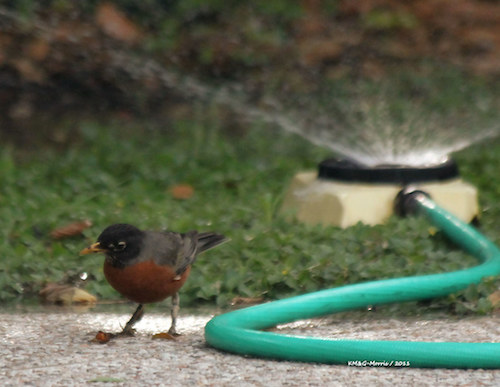Models of environmental conditions demonstrate that long term drought can affect the species diversity of birds. The lack of water and the temperature that goes along with it stresses the birds, although different species may respond differently.I can see the effects in my own backyard in northern California. The winter of 2019-2020 saw a reasonable amount of rainfall. The following spring I heard and saw a variety of songbirds singing and nesting my yard; every one of my six nest boxes was utilized. Tree Swallows, Western Bluebirds, Bewick’s Wrens, Oak Titmice, and Ash-throated Flycatchers all used nestboxes. In the fall of 2020 I built and placed six more nest boxes. But that winter saw a disappointing rainfall, much lower than normal. The next spring I was disappointed to hear fewer birds and found no next boxes being used. Tree Swallows disappeared and Ash-throated Flycatcher sightings were rare, but Nuttall’s Woodpeckers and White breasted Nuthatches were more common.
What does the drought do to bird habitat? First, the lack of moisture and hot temperatures considerably decrease the insect population. The insects seek shelter and fly less, being less accessible to birds. Ninety-six percent of terrestrial birds eat insects, so a diminished food supply means less successful breeding. Second, because trees and shrubs save their energy just to survive through the drought they don’t produce as much or any fruit, so food such as seeds, nuts, and berries are also scarcer.

With less food and water available, birds have to spend more of their daily activity time seeking these resources. This means time taken away from courtship, nest building, territory defense, incubation, feeding young, more exposure to predation, and more energy put into survival and less into producing eggs.
The effect of drought conditions varies with habitat and bird species. In one study in Malaysia, researchers found that long-lived bird species reduced their reproduction during periods of drought. This allowed them to reduce their stress and maintain a high survival rate. Short-lived species, like most songbirds, tried to maintain their usual rate of reproduction which resulted in a 30-50% decrease in their survival rate. So longer-lived species seem to be more resilient and capable of withstanding periods of drought than the short-lived species. An older study found that during a drought in a montane habitat, insectivorous bird populations also decreased, nectivorous birds (hummingbirds) disappeared, but granivorous (seed eating birds) increased.
It’s complicated. Another study of 45 bird species in the Sierra Nevada found that 47% react positively to climate warming and only 20% negatively. The authors note that “As other studies have shown, climate warming may lead to substantial but idiosyncratic effects on wildlife species that could result in community composition shifts.”
Observations in my backyard are just anecdotal and mean little, but clearly something is happening as I regularly hear from others across the country that they are observing similar changes in response to our changing climatic conditions.
We, you and I, can do something. If you don’t already have one, a bird bath would be most beneficial. In addition, a bowl or large container of water at ground level would be helpful not only to birds but ground dwelling mammals as well as insects. Watch for mosquito larvae, though.
I like this article very much